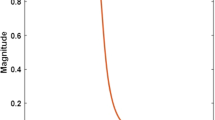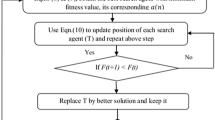Abstract
Circuit design optimization has become a common research to reduce the manpower and computational resource required for circuit design industries. Despite the involvement of multiple design objectives, higher order circuit designs are often more complicated and difficult to be optimized using conventional circuit tuning method. This paper proposed Strength Pareto Evolutionary Algorithm 2 (SPEA2) to optimize a ninth order multiple feedback Chebyshev low pass filter. This research aims to search the best trade-off solution that could minimize the passband ripple, maximize the gain and achieve the targeted cutoff frequency. The NGSPICE circuit simulator is interacted with SPEA2 algorithm to perform the circuit optimization. The results obtained show the reliability of the algorithm in achieving the required optimization objectives.
Access provided by Autonomous University of Puebla. Download conference paper PDF
Similar content being viewed by others
Keywords
- Nondominated Solution
- Environmental Selection
- Circuit Optimization
- Binary Tournament Selection
- Fitness Assignment
These keywords were added by machine and not by the authors. This process is experimental and the keywords may be updated as the learning algorithm improves.
1 Introduction
Multi-Objective Evolutionary Algorithms (MOEAs) become a popular research in electronic and circuit optimization since the last decade [1–7]. The implementation of MOEA in RF design has been conducted by Huang in [1] whereas a vector Tabu search algorithm has been proposed to produce a good distribution of the Pareto solutions in antenna array by Kashfi et al. [3]. Besides that, multi-objective genetic algorithm (MOGA) has been developed to optimize the soft error tolerance of the standard cell circuit by Song et al. [4].
Active filters are widely used in the area of instrumentation, communication and automatic control [8]. The design of a higher order filter often involves large number of components. Meanwhile, according to [9], the higher order filter has a performance approaching ideal filter. As a result, the design of a higher order filter is tedious and challenging. In this research, we develop a SPEA2-based filter optimizer to assist the time consuming circuit tuning process of a ninth order multiple feedback Chebyshev low pass filter.
2 Ninth Order Multiple Feedback Chebyshev Low Pass Filter
Multiple feedback low pass filter is widely used in electronic systems, such as electronic devices, telecommunications, medical instruments and etc. The function of filter design in this application is to filter out the unwanted noise and get the clear information from the signal received.
Ninth order multiple feedback Chebyshev filter shown in Fig. 1 is designed by cascading resistor-capacitor filter with five selected AD797 operational amplifiers from spice library. The complexity of circuit design is directly proportional to the order of the filter. The higher the order of the filter, the more the parameters required to be optimized. Resistors and capacitors are components that will affect the performance of the filter, thus, optimum parameter setting of these components is vital to achieve the design objectives such as gain, cutoff frequency and passband ripple. Table 1 depicts the design objectives/specifications for the ninth order multiple feedback Chebyshev low pass filter. The resistors and capacitors in the filter are to be optimized within the feasible range of values listed in Table 2.
3 Strength Pareto Evolutionary Algorithm 2 (SPEA2)
SPEA2 [10] is an improved version of SPEA [10] in terms of archive truncation methods for solution preservation. The algorithm increases the precision during the searching process by using nearest neighbor density estimation technique and also the domination counter as the fitness assignment scheme. Pseudo code of SPEA2 is shown in Fig. 2.
In this research, SPEA2 is started with a random initialization of a population of possible solutions, \(P_{t}\), with size of M, and empty set of archive, \(Z_{t}\), with size N, whereby t represents the generation number. We then compute fitness values for candidate solutions in both \({\mathbb{P}}_{t}\) and \(Z_{t}\) according to the fitness assignment method shown in Sect. 3.1. Based on the Pareto dominance concept given in [12], all nondominated vectors are moved to a new archive, \(Z_{t + 1}\). In this operation, there are two possible situations: (i) if the number of solutions in \(Z_{t + 1}\) is more than N then truncation operator [11] will remove the vectors; (ii) if number of \(Z_{t + 1}\) is less than N, then the empty space in \(Z_{t + 1}\) ill be filled with dominated vectors using environmental selection given in Sect. 3.2. Subsequently, the mating pool is filled with solutions that are selected from \(P_{t}\) by binary tournament selection and gone through the process of crossover and mutation. The offspring population is formed after execution of genetic operators. Optimization is then continued from generation to generation until the required filter specifications or the maximum generation number is achieved. At the end of optimization, the best set of nondominated solutions is obtained as the best Pareto optimal front and the best proposed solution of SPEA2 is selected from these set of solutions by comparing its close proximity towards the filter design objectives in Table 1.
3.1 Fitness Assignment
SPEA2 [11] calculates the fitness value according to Eq. (1) where the total fitness value of an individual or candidate solution is equal to the summation of density, \(D(i)\) and raw fitness value, \(R(i)\)
Density is defined in Eq. (2) where \(\sigma_{i}\) is the density estimator of individual i to nearest neighbor and \(k = \sqrt {N + \overline{N} }\) where k is equal to the square root of the sample [11].
Pareto dominance concept [12] is applied to all the individual in the population and archive. Raw fitness calculates the number of dominator, from both archive, \(Z_{t}\) and population, \(P_{t}\) as Eq. (3). Note that the value of raw fitness is to be minimized where \(R(i) = 0\) will be assigned to nondominated solutions.
3.2 Environmental Selection
Environmental selection is the archive update operation of SPEA2. The selection of the individual is conducted according to Eq. (4) in which solutions with fitness value lower than 1 are selected into archive of next generation, \(Z_{t + 1}.\)
There is a situation when the archive is not fully contain with the nondominated individual, then the dominated individual is inserted to the archive until the archive achieves the size of N.
3.3 SPEA2 Evolutionary Parameter Setting
The proposed SPEA2 adopts the optimization setting listed in Table 3 where population size of 20 and archive size of 100 are used with maximum 500 evaluations. Genetic operators chosen for this optimization are SBX crossover [13], polynomial mutation [14] and binary tournament selection.
In this research, the filter performance is simulated using the NGSPICE circuit simulator. The developed SPEA2 optimizer is interacted with NGSPICE to optimize the circuit performance interactively as shown in Fig. 3. First, the population of possible filter design setting will undergo the NGSPICE simulation. Then the performance obtained from the simulation is fed to the proposed SPEA2 for evolutionary optimization (Fig. 2) whereby the fitness assignment, environmental selection and genetic operator will be executed to produce offspring to the next generation. This optimization process is repeated until the required specifications are achieved or maximum number of evaluation is reached.
4 Results and Discussion
Based on the model in Fig. 3, the solutions that produce the best tradeoff among all design objectives are obtained. These solutions are visualized in a Pareto plot as illustrated in Fig. 4. We chose the best point from the solutions suggested by SPEA2 which fulfills the objective specifications. The dark blue color dots are the solutions that achieved the passband ripple requirement (0–1 dB). In order to choose as the best solution, the other two objectives, gain (25.37–26.67 dB) and cutoff frequency (975–1025 Hz) must achieve. Thus, the dot scattered in the region/specification range given in Table 1 has been spotted and the output performance and suggested design variable of the best spotted solution is depicted in Tables 4 and 5 respectively.
The characteristic of the optimized solution is shown in the bode plot graph in Fig. 5. The bode plot that shows the low pass filter characteristic illustrates the output gain of 25.78 dB, the passband ripple of 0.085 dB with the cutoff frequency at 1000.78 Hz.
5 Conclusions
In this paper, SPEA2 is interacted with the NGSPICE circuit simulator to optimize the ninth order multiple feedback Chebyshev low pass filter. Despite the complexity of higher order filter, the proposed SPEA2-NGSPICE model is capable to obtain the required design specifications. Overall, 19 decision variables are involved and three design objectives are to be achieved in the experiment. The proposed SPEA2 is shown to perform well and managed to obtain output gain of 25.78 dB, passband ripple of 0.085 dB, and cutoff frequency of 1000.78 Hz which is within the feasible region of specification requirements. Thus, SPEA2 is a potential tool to assist circuit design tuning and further exploration on MOEAs-based circuit optimization is possible in future.
References
Huang, W.-T., et al.: Multiobjective evolutionary approach to silicon solar cell design optimization. In: 2013 5th Asia Symposium on Quality Electronic Design (ASQED) (2013)
Kashfi, F., Hatami, S., Pedram, M.: Multi-objective optimization techniques for VLSI circuits. In: 2011 12th International Symposium on Quality Electronic Design (ISQED) (2011)
Ho, S.L., Shiyou, Y.: Multiobjective synthesis of antenna arrays using a vector tabu search algorithm. IEEE Antenna Wirel. Propag. Lett. 8, 947–950 (2009)
Song, W., Multiobjective memetic algorithm and its application in robust airfoil shape optimization. In: Goh, C.-K., Ong, Y.-S., Tan, K. (eds.) Multi-Objective Memetic Algorithms, pp. 389–402. Springer Berlin Heidelberg (2009)
Liyi, X., Weiguang, S., Zhigang, M.: Soft error optimization of standard cell circuits based on gate sizing and multi-objective genetic algorithm. In: Design Automation Conference, 2009. DAC ‘09. 46th ACM/IEEE (2009)
Michal, J., Dobes, J.: Electronic circuit design using multiobjective optimization. In: 50th Midwest Symposium on Circuits and Systems, 2007. MWSCAS (2007)
Sag, T., Cunkas, M.: Multiobjective genetic estimation to induction motor parameters. In: International Aegean Conference on Electrical Machines and Power Electronics, 2007. ACEMP ‘07 (2007)
Pirajnanchai, V., Benjankaprasert, C., Janchitrapongvej, K.: Active low pass notch filter using multielectrode distributed RC circuit. In: 2010 7th International Symposium on Communication Systems Networks and Digital Signal Processing (CSNDSP) (2010)
Su, K.L.: Analog Filters. Springer, New York (1996)
Zitzler, E., Thiele, L.: Multiobjective evolutionary algorithms: a comparative case study and the strength Pareto approach. IEEE Trans. Evol. Comput. 3(4), 257–271 (1999)
Zitzler, E., Laumanns, M., Thiele, L.: SPEA2: Improving the strength Pareto evolutionary algorithm. Eidgenössische Technische Hochschule Zürich (ETH), Institut für Technische Informatik und Kommunikationsnetze (TIK) (2001)
Deb, K.: Introduction to evolutionary multiobjective optimization. In: Branke, J. et al. (eds.) Multiobjective Optimization, pp. 59–96. Springer, Berlin (2008)
Deb, K., et al.: A fast and elitist multiobjective genetic algorithm: NSGA-II. IEEE Trans. Evol. Comput. 6(2), 182–197 (2002)
Agrawal, R.B., Deb, K., Agrawal, R.B.: Simulated binary crossover for continuous search space (1994)
Author information
Authors and Affiliations
Corresponding author
Editor information
Editors and Affiliations
Rights and permissions
Copyright information
© 2015 Springer International Publishing Switzerland
About this paper
Cite this paper
Lim, W.J. et al. (2015). Strength Pareto Evolutionary Algorithm 2 in Optimizing Ninth Order Multiple Feedback Chebyshev Low Pass Filter. In: Sulaiman, H., Othman, M., Abd. Aziz, M., Abd Malek, M. (eds) Theory and Applications of Applied Electromagnetics. Lecture Notes in Electrical Engineering, vol 344. Springer, Cham. https://doi.org/10.1007/978-3-319-17269-9_4
Download citation
DOI: https://doi.org/10.1007/978-3-319-17269-9_4
Published:
Publisher Name: Springer, Cham
Print ISBN: 978-3-319-17268-2
Online ISBN: 978-3-319-17269-9
eBook Packages: EngineeringEngineering (R0)









